![]()
![]()
![]()
Use LEFT and RIGHT arrow keys to navigate between flashcards;
Use UP and DOWN arrow keys to flip the card;
H to show hint;
A reads text to speech;
160 Cards in this Set
- Front
- Back
|
Social constructionism |
What is reality here |
|
|
Symbolic Interactionism |
It's a perspective in sociology. Focuses or study, how people Use symbols and other communications(words,or gestures) to connect and makes sense of their world. understand how it shapes societal relationships and influence our interactions. |
|
|
Functional theory |
Like Neurons and Brains. Each part has a role; functions for stability and order. Homeostasis . Parts are various structures/aspects of society such as family, school, religious organization,govt etc |
|
|
Conflict theory |
Society as battle ground. Competition of different groups on their self interests. The perspective Highlights inequalities and conflicts b/w different groups: Feminist theory can be a part of this theory, men vs woman. |
|
|
Trace decay theory |
Trace decay theory is a psychological theory that suggests forgetting occurs because memories fade or decay with time when not used or rehearsed. |
|
|
Proactive interference |
Proactive interference occurs when previously learned information interferes with the ability to recall new information. |
|
|
Retroactive interference |
Opposite of proactive |
|
|
Flash bulb memory 💡 |
A flashbulb memory is a highly detailed, exceptionally vivid 'snapshot' of the moment and circumstances in which a piece of surprising and consequential (or emotionally arousing) news was heard. |
|
|
Yerkes-Dodson law |
The law implies that a moderate amount of stress or arousal can enhance performance, but too much or too little can be detrimental. |
|
|
James Lange theory |
About emotion. emotions arise from our awareness of physiological reactions to stimuli, suggesting that our emotional experience follows our body's response. Boom 💥=>[ bodily reaction>> emo(fear)] |
|
|
Cannon-bard theory |
emotions and physiological reactions happen concurrently but are separate processes. 💥 =>[ emo + physiological response] |
|
|
Schachter theory |
Aka: 2 factor theoryboth physiological arousal and cognitive appraisal are necessary for the experience of emotion. In simpler terms, emotions are a result of how we interpret our bodily sensations in a given situation.💥 =>[physiological reactions =>evaluate => label=> experience emotion according to that appraisal]Use singer to associate: singing and it's appraisal creates emotion. Aka: 2 factor theoryboth physiological arousal and cognitive appraisal are necessary for the experience of emotion. In simpler terms, emotions are a result of how we interpret our bodily sensations in a given situation.💥 =>[physiological reactions =>evaluate => label=> experience emotion according to that appraisal]Use singer to associate: singing and it's appraisal creates emotion. Aka: 2 factor theoryboth physiological arousal and cognitive appraisal are necessary for the experience of emotion. In simpler terms, emotions are a result of how we interpret our bodily sensations in a given situation.💥 =>[physiological reactions =>evaluate => label=> experience emotion according to that appraisal]Use singer to associate: singing and it's appraisal creates emotion. Aka: 2 factor theoryboth physiological arousal and cognitive appraisal are necessary for the experience of emotion. In simpler terms, emotions are a result of how we interpret our bodily sensations in a given situation.💥 =>[physiological reactions =>evaluate => label=> experience emotion according to that appraisal]Use singer to associate: singing and it's appraisal creates emotion. Aka: 2 factor theoryboth physiological arousal and cognitive appraisal are necessary for the experience of emotion. In simpler terms, emotions are a result of how we interpret our bodily sensations in a given situation.💥 =>[physiological reactions =>evaluate => label=> experience emotion according to that appraisal]Use singer to associate: singing and it's appraisal creates emotion. |
|
|
Hawthorne effect |
The Hawthorne Effect refers to the alteration of human behavior when individuals are aware that they are being observed. Aka: observer effect |
|
|
Lazarus cognitive mediational theory |

Lazarus's theory suggests that it's not the external event alone that elicits emotion, but rather the individual's appraisal and interpretation of the event.Note: In two factor both appraisal and physiological response is needed to elicit emotions Lazarus's theory suggests that it's not the external event alone that elicits emotion, but rather the individual's appraisal and interpretation of the event.Note: In two factor both appraisal and physiological response is needed to elicit emotions |
|
|
What stage of Piaget, conservation is understood? |
Concrete Operational (7 to 11) |
|
|
When does ability to use language develop and symbolic thoughts- piaget stages |
Preoperational 2 to 7 |
|
|
Galton's Idea of hereditary genius |
Sir Francis Galton, a Victorian-era scientist, introduced the concept of "hereditary genius" in the 19th century. He proposed that intelligence and other traits were inherited and passed down through generations, suggesting a strong genetic component to human abilities. |
|
|
Binets idea of mental age |
Alfred Binet, a French psychologist, developed the concept of "mental age" in the early 20th century. He introduced it as a way to assess intelligence in children. The idea is that an individual's performance on an intelligence test should correspond to their mental age, or the level of intellectual functioning typical for their chronological age. This concept became a crucial component in the development of IQ (intelligence quotient) tests, although it's important to recognize the limitations and cultural biases associated with such assessments. |
|
|
Edward Thorndike's theory of three intelligences?! |
Edward Thorndike's theory of three intelligences, proposed in the early 20th century, outlined three distinct types of intelligence:1. **Concrete Intelligence:** This involves the ability to understand and work with concrete objects and situations. It is more focused on practical and tangible aspects.2. **Abstract Intelligence:** Thorndike referred to abstract intelligence as the ability to grasp and manipulate ideas, symbols, and relationships. It involves conceptual thinking and problem-solving in a more abstract context.3. **Social Intelligence:** This type of intelligence relates to understanding and interacting effectively with other people. Social intelligence encompasses skills such as empathy, social awareness, and the ability to navigate social situations.While Thorndike's three intelligences have contributed to the broader understanding of cognitive abilities, it's important to note that contemporary psychology has developed more nuanced and comprehensive models of intelligence, such as Howard Gardner's theory of multiple intelligences. |
|
|
Howard Gardner's theory of multiple intelligences |
Howard Gardner's theory of multiple intelligencesHoward Gardner's theory of multiple intelligences proposes that there are several distinct types of intelligences, rather than a single, unitary intelligence. Gardner initially identified seven intelligences, and later expanded to include additional ones. The original seven are:1. **Linguistic Intelligence:** Involves a strong ability with language and words. 2. **Logical-Mathematical Intelligence:** Centers around logical reasoning and mathematical abilities.3. **Spatial Intelligence:** Relates to understanding and manipulating spatial relationships and visualizing objects in space.4. **Musical Intelligence:** Involves a sensitivity to sounds, rhythms, and music.5. **Bodily-Kinesthetic Intelligence:** Encompasses physical coordination, agility, and a keen sense of body awareness.6. **Interpersonal Intelligence:** Involves understanding and interacting effectively with others, demonstrating empathy and social skills.7. **Intrapersonal Intelligence:** Pertains to self-awareness, self-reflection, and a deep understanding of one's own emotions and motivations.Gardner later added additional intelligences, such as Naturalist Intelligence and Existential Intelligence. This theory suggests that individuals may excel in one or more of these intelligences, highlighting the diversity of human cognitive abilities. |
|
|
Spearman's theory of intelligence |
Spearman's theory suggests that while individuals may have specific skills or talents, there is an overarching and general intelligence factor that contributes to their performance across a range of cognitive tasks. This concept of a single, underlying intelligence factor has been influential in the history of intelligence testing. G factor(general) And S factor (for special and specific) |
|
|
Humanistic Theory |
Humanistic theory emphasizes personal growth, self-actualization, and the importance of individual experiences and feelings in understanding human behavior. It focuses on fulfilling one's potential and the belief that people naturally strive for positive development. Abraham Maslow and Carl Rogers. |
|
|
What's Freud psychoanalytic theory |
Freud's psychoanalytic theory suggests that the mind has three parts: the id (instincts), ego (reasoning), and superego (morality). He also introduced the idea of psychosexual stages, emphasizing early childhood experiences' impact on personality development, and the role of the unconscious mind. |
|
|
Freud 8 stages |
1. **Oral Stage (0-1 years):** - Focus on mouth-related pleasure.2. **Anal Stage (1-3 years):** - Focus on bowel and bladder control.3. **Phallic Stage (3-6 years):** - Focus on genitalia, emergence of Oedipus and Electra complexes.4. **Latency Stage (6-11 years):** - Focus on social and intellectual development.5. **Genital Stage (Puberty Onward):** - Re-emergence of sexual desires, pursuit of mature relationships. |
|
|
Traits theory |
Trait theory explores the idea that each person possesses enduring qualities, known as traits, that shape their consistent patterns of behavior, thoughts, and emotions. These traits are like the building blocks of personality and are often measured using tools like the Myers-Briggs Type Indicator or organized into dimensions, such as the Big Five. The theory assumes that these traits remain relatively stable over time and across various situations, aiming to predict behavior based on an individual's trait profile. While trait theory has been applied in psychology, human resources, and career counseling for understanding individual differences, critics argue about the stability of traits and the impact of situational factors on behavior. |
|
|
Psychoanalytic or psychodynamic theory |
Psychoanalytic or psychodynamic theory, developed by Sigmund Freud, explores the unconscious mind's influence on behavior and personality. This theory suggests that our thoughts and actions are driven by unconscious desires and conflicts stemming from early childhood experiences. Freud proposed that the mind consists of three components: the conscious mind, the preconscious mind, and the unconscious mind. Additionally, he introduced the idea of three personality structures: the id (instinctual desires), the ego (conscious self), and the superego (internalized moral standards). The psychodynamic approach involves exploring the unconscious through techniques like free association and dream analysis. While some aspects of Freud's theories have been criticized, psychodynamic ideas have influenced psychology, particularly in understanding the importance of early experiences and the unconscious in shaping human behavior. |
|
|
Social Cognitive theory |
Social Cognitive Theory, developed by Albert Bandura, emphasizes the role of observational learning, imitation, and social influence in shaping behavior. This theory suggests that individuals learn not only from direct experiences but also by observing others and modeling their actions. Also, Social Cognitive Theory has been widely applied in various fields, including education, psychology, and communication. It provides insights into how individuals learn from their social environment, how role models influence behavior, and the importance of self-efficacy in determining the likelihood of behavior change. |
|
|
Behavioral theory |
Behavioral theory, often associated with behaviorism, is a psychological perspective that focuses on observable behaviors rather than internal mental processes. This theory emphasizes the role of the environment in shaping and controlling behavior through stimulus-response associations |
|
|
Difference between social Cognitive Theory and Behavioral theory |
The main difference is that Social Cognitive Theory incorporates cognitive processes and observational learning, emphasizing the active role of individuals in shaping their behavior, while Behavioral Theory primarily concentrates on observable behaviors and external stimuli, with less emphasis on internal mental processes. |
|
|
What's functional fixedness |
Functional fixedness is a cognitive bias that limits a person to use an object only in the way it is traditionally used. It hinders creative problem-solving by restricting the individual from seeing alternative uses for an object beyond its conventional function. |
|
|
Bottom up and Top down Processing |
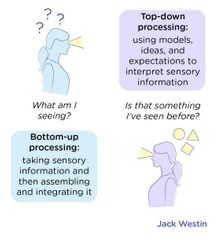
|
|
|
Internal locus of control |
When someone has an internal locus of control, they believe that their actions, decisions, and efforts directly influence the results they experience. |
|
|
External locus of control |
external factors, rather than their own actions or decisions, largely influence the outcomes of their life. |
|
|
Fundamental attribution error |
tendency of individuals to attribute other people's behaviors to internal characteristics or personal traits, while underestimating the influence of external factors |
|
|
Self fulfilling prophecy |
person's expectations or predictions about a future event may lead them to behave in ways that make the outcome more likely to occur. |
|
|
The self-serving bias |
The self-serving bias is a cognitive bias that involves individuals attributing positive events and successes to their own character, abilities, or efforts, while attributing negative events and failures to external factors beyond their control. Essentially, people tend to take credit for their successes but attribute their failures to external circumstances or other people. |
|
|
The actor-observer bias |
The actor-observer bias is a cognitive bias that refers to the tendency for individuals to attribute their own actions to external factors (situation or circumstances) while attributing the actions of others to internal factors (dispositions or personality traits). In other words, people often explain their own behavior by considering the external context, but when observing others, they tend to focus more on internal traits. |
|
|
Peer pressure |
Peer pressure refers to the influence exerted by peers or a social group that encourages individuals to change their attitudes, behaviors, or actions in order to conform to group norms or expectations. This influence can be direct or indirect and may involve both positive and negative aspects. |
|
|
Kohlberg's Theory of Moral Development:** |
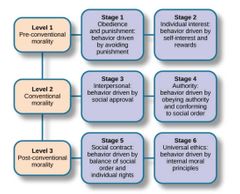
**Kohlberg's Theory of Moral Development:**- **Level 1: Preconventional Morality** - Stage 1: Obedience and Punishment - Stage 2: Individualism and Exchange- **Level 2: Conventional Morality** - Stage 3: Interpersonal Relationships - Stage 4: Maintaining Social Order- **Level 3: Postconventional Morality** - Stage 5: Social Contract and Individual Rights - Stage 6: Universal Principles**Key Points:**- Progression through stages.- Preconventional (self-interest), Conventional (social norms), Postconventional (universal principles).- Stages depict evolving moral reasoning. |
|
|
Rational choice theory |
( to analyze human behavior)and make choices based on cost and benefits, based on their self interest |
|
|
Exchange theory |
Focuses on social interactions as a series of exchanges, emphasizing the rewards and costs involved. It suggests that individuals engage in relationships or transactions based on the expectation of receiving greater benefits than the costs incurred.Eg: take the case of friendship. Evaluating What's in it (in return) and what's out (the time investment.etc) Focuses on social interactions as a series of exchanges, emphasizing the rewards and costs involved. It suggests that individuals engage in relationships or transactions based on the expectation of receiving greater benefits than the costs incurred.Eg: take the case of friendship. Evaluating What's in it (in return) and what's out (the time investment.etc) |
|
|
Folkways-mores-taboo |
Casual-Serious- Weird and repulsive |
|
|
Social group : |
group identity among a set of individuals created by collection if shared experiences. |
|
|
Why is culture important?!! |
Because cultural differences influences interpretations, reactions and understandings of behavior of others. And knowing people's underlying beliefs about the world are varied make it easy to understand why human behavior is variable. |
|
|
Distinguish between Experimental and Observational studies,(just say it in your words) flip for reference |

|
|
|
Distinguish b/w longitudinal study and cross-sectional study |
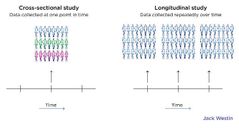
|
|
|
Define in single word or sentence,1. Polycistronic2.polygenic3.polyphenic4.polyploidy |
1. Polycistronic: **Multiple genes on one mRNA.**2. Polygenic: **Controlled by multiple genes.**3. Polyphenic: **Single genotype produces multiple phenotypes.**4. Polyploidy: **Possessing multiple sets of chromosomes.** |
|
|
Utilities of each scan, PET,EEG,CT,MRi,fMri. |

|
|
|
What's quasi experimental studies |
Quasi-experimental studies are research designs that investigate the effects of interventions or treatments without random assignment, often using existing groups for comparison. |
|
|
Contrast double blind and single blind study |
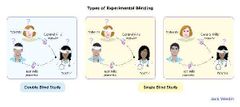
|
|
|
Big fives/ five factor model personality |
Ocean |
|
|
ABC of attitude |
ABC |
|
|
Stereotype,Prejudice,Discrimination Stereotype,Prejudice,DiscriminationCorrespond these to components of the attitude. Stereotype,Prejudice,DiscriminationCorrespond these to components of the attitude. Correspond these to components of the attitude. |
C- A - B ,respectively. |
|
|
Age of sensory motor? 2 characteristics , when it ends |
0 to 2, Repeatative yo yo, lack of object permanence. It ends when the child gains object permanence |
|
|
Pre-operational stage |
Ego-centrism, 2 to 7 years old. Can't wear others shoe. Lack of understanding of conservation of mass( surface understanding). Can understand symbols( understand stop signs ) |
|
|
Concrete Operational stage.
|
Discarded Ego centrism(can wear other's 👞)Understands conservations.Logical reasoning with concrete objects Discarded Ego centrism(can wear other's 👞)Understands conservations.Logical reasoning with concrete objects Discarded Ego centrism(can wear other's 👞)Understands conservations.Logical reasoning with concrete objects |
|
|
Formal operational stage:11+ |
Abstract reasoning- hypothetical scenarios etc |
|
|
Criticism of Piagets stage |
Many children advance too earlier than he said |
|
|
Binocular Cues |
Gives sense of depth from two eyes with the retinal disparity |
|
|
What's downregulation and upregulation of vision |
Downregulation of eyes involves decreased sensitivity to light due to prolonged bright light exposure, while upregulation enhances sensitivity in low light conditions, aiding in visual adaptation by adjusting the response of photoreceptors and neural pathways, including changes in the expression or activity of proteins like opsins involved in light detection. |
|
|
What's JND in weber law |
The threshold at which you’re able to notice a change in any sensation is the just noticeable difference (JND) |
|
|
What's weber law |
Weber's Law states that the just noticeable difference (JND) between two stimuli is proportional to the magnitude of the stimuli. In simpler terms, it means that the change needed to notice a difference between two stimuli is a constant ratio of the original stimulus intensity. For example, if you can detect a 10% change in weight of an object weighing 100 grams, according to Weber's Law, you should also be able to detect a 10% change in weight of an object weighing 200 grams. This demonstrates that the just noticeable difference (ΔI) is proportional to the original stimulus intensity (I). ◇I(jnd)/I= k |
|
|
Absolute Threshold |
Absolute threshold of sensation: The minimum intensity of stimulus needed to detect a particular stimulus 50% of the time. |
|
|
Difference between JND and Absolute threshold |
while both concepts relate to the detection of stimuli, the JND focuses on the smallest detectable change in stimulus intensity, whereas the absolute threshold focuses on the lowest intensity of a stimulus that can be detected. |
|
|
4 psychological states, that can influence absolute threshold |
Experience Expectations Motivation Alertness. |
|
|
Subliminal stimuli |
Subliminal stimuli are sensory inputs presented below the threshold of conscious perception. |
|
|
4 types of somatosensation |
Temperature (thermoception), pressure (mechanoception), pain (nociception), and position (proprioception) |
|
|
Intensity of somatosensation |
The intensity of somatosensation can also be influenced by the frequency and pattern of neuronal firing in response to the sensory stimulus. Higher frequencies of firing can be associated with stronger sensations, while lower frequencies may correspond to weaker sensations. |
|
|
3 timings of neurons, adaptation |
Neuron encodes 3 ways for timing: non adapting, fast adapting, or slow adapting |
|
|
Where is vestibular system located? Components of vestibular system? Functions? |
**Vestibular System:** - Location: Inner ear. - Components: Semicircular canals and otolith organs. - Function: Contributes to balance and spatial orientation. |
|
|
What does Semicircular canals sense and what does Otolith organs Detect? |
. **Semicircular Canals and Otolith Organs:** - Semicircular canals: Detect rotational head movements. - Otolith organs (utricle and saccule): Detect linear head movements and gravitational forces. - Together, they provide information for maintaining balance and coordinating movement. |
|
|
Role of vestibular system in sensory integration. |
Role in Sensory Integration: - Helps stabilize vision during head movement. - Provides input for postural control and coordination. - Contributes to the overall sense of balance and orientation. |
|
|
What's the fluid seen in Semicircular canal |
Endolymph |
|
|
what is that your body gets with the help of endolymph in Semicircular canal? |
By sensing the direction of its motion and speed at which it moves, direction of head movement and intensity at which head moves. Or angular acceleration and deceleration. To sense rotational movements in various planes! |
|
|
Talk about Utricle and Saccule in detail |
Both are involved in linear acceleration and motion based on gravity. Utricle more tilting and Saccule more vertical(lift). Sure, here's a simple explanation of the functions and components of the utricle and saccule:1. **Utricle:** The utricle helps you keep your balance and know which way is up. It has tiny crystals inside called otoliths, which move when you tilt your head or move around. These movements tell your brain how your head is positioned relative to gravity, like when you bend forward or lean to the side.2. **Saccule:** The saccule also helps with balance, especially when you're moving up or down. It's similar to the utricle but focuses more on vertical movements. Like the utricle, it contains otoliths that move and send signals to your brain when you're going up in an elevator or down a flight of stairs. |
|
|
What are otoliths |
Otoliths are tiny calcium carbonate crystals in the inner ear that help detect changes in head position and linear acceleration. They pull on hairballs causing AP |
|
|
List the movements detected by all three components of inner ear (x2) |
1. Tilting the head sideways2. Nodding the head up and down |
|
|
List the things detected by utricle and saccule (x5) |
Forward and backward movements of the head. Upward and downward movements of the head. Tilting of the head downward and upward. Sideways movements of the head, such as tilting to the left or right. Changes in head velocity, including acceleration and deceleration. |
|
|
Things detected by Semicircular canal(×2) |
Rotational movements of the head in different planes, such as turning the head to the left or right, tilting the head sideways, or nodding the head. Changes in angular velocity, including acceleration and deceleration during rotational movements. |
|
|
What does signal detection theory offers |
It understands how indivuduals detect signal in various situations such as noise. |
|
|
4 options in signal detection theory |
Hit,miss, false alarm,correct rejection |
|
|
TYPE I <> TYPE II ERROR |
False positive <> false negative |
|
|
In signal DT, what's c , what's d' |
( d' ) measures how well someone can tell the difference between a signal and noise. In other words, D' tells how well the responder of the signal can discriminate between signal and noise.(on graph: its difference between means of noise and signal)
( c ) represents how cautious or liberal someone is in making a decision based on the evidence. |
|
|
Two strategies in SDT |
Conservative and liberal |
|
|
Bottom up processing |
Start: Sensory Input v Sensory Processing vPerceptual Organization v Higher-Level Processing v Response/BehaviorEndNote:1. No preconceived cognitive constructs of the stimulus (never seen it before) 2. Data driven. And the stimulus directs cognitive awareness of what you’re looking at (object) 3. Inductive Reasoning.(specific/concrete to General ,as in bottom up) Start: Sensory Input v Sensory Processing vPerceptual Organization v Higher-Level Processing v Response/BehaviorEndNote:1. No preconceived cognitive constructs of the stimulus (never seen it before) 2. Data driven. And the stimulus directs cognitive awareness of what you’re looking at (object) 3. Inductive Reasoning.(specific/concrete to General ,as in bottom up) Start: Sensory Input v Sensory Processing vPerceptual Organization v Higher-Level Processing v Response/BehaviorEndNote:1. No preconceived cognitive constructs of the stimulus (never seen it before) 2. Data driven. And the stimulus directs cognitive awareness of what you’re looking at (object) 3. Inductive Reasoning.(specific/concrete to General ,as in bottom up) Start: Sensory Input v Sensory Processing vPerceptual Organization v Higher-Level Processing v Response/BehaviorEndNote:1. No preconceived cognitive constructs of the stimulus (never seen it before) 2. Data driven. And the stimulus directs cognitive awareness of what you’re looking at (object) 3. Inductive Reasoning.(specific/concrete to General ,as in bottom up) Start: Sensory Input v Sensory Processing vPerceptual Organization v Higher-Level Processing v Response/BehaviorEndNote:1. No preconceived cognitive constructs of the stimulus (never seen it before) 2. Data driven. And the stimulus directs cognitive awareness of what you’re looking at (object) 3. Inductive Reasoning.(specific/concrete to General ,as in bottom up) Start: Sensory Input v Sensory Processing vPerceptual Organization v Higher-Level Processing v Response/BehaviorEndNote:1. No preconceived cognitive constructs of the stimulus (never seen it before) 2. Data driven. And the stimulus directs cognitive awareness of what you’re looking at (object) 3. Inductive Reasoning.(specific/concrete to General ,as in bottom up) |
|
|
Bottom up processing |
Start: Sensory Input v Sensory Processing vPerceptual Organization v Higher-Level Processing v Response/BehaviorEndNote:1. No preconceived cognitive constructs of the stimulus (never seen it before) 2. Data driven. And the stimulus directs cognitive awareness of what you’re looking at (object) 3. Inductive Reasoning.(specific/concrete to General ,as in bottom up) Start: Sensory Input v Sensory Processing vPerceptual Organization v Higher-Level Processing v Response/BehaviorEndNote:1. No preconceived cognitive constructs of the stimulus (never seen it before) 2. Data driven. And the stimulus directs cognitive awareness of what you’re looking at (object) 3. Inductive Reasoning.(specific/concrete to General ,as in bottom up) Start: Sensory Input v Sensory Processing vPerceptual Organization v Higher-Level Processing v Response/BehaviorEndNote:1. No preconceived cognitive constructs of the stimulus (never seen it before) 2. Data driven. And the stimulus directs cognitive awareness of what you’re looking at (object) 3. Inductive Reasoning.(specific/concrete to General ,as in bottom up) Start: Sensory Input v Sensory Processing vPerceptual Organization v Higher-Level Processing v Response/BehaviorEndNote:1. No preconceived cognitive constructs of the stimulus (never seen it before) 2. Data driven. And the stimulus directs cognitive awareness of what you’re looking at (object) 3. Inductive Reasoning.(specific/concrete to General ,as in bottom up) Start: Sensory Input v Sensory Processing vPerceptual Organization v Higher-Level Processing v Response/BehaviorEndNote:1. No preconceived cognitive constructs of the stimulus (never seen it before) 2. Data driven. And the stimulus directs cognitive awareness of what you’re looking at (object) 3. Inductive Reasoning.(specific/concrete to General ,as in bottom up) Start: Sensory Input v Sensory Processing vPerceptual Organization v Higher-Level Processing v Response/BehaviorEndNote:1. No preconceived cognitive constructs of the stimulus (never seen it before) 2. Data driven. And the stimulus directs cognitive awareness of what you’re looking at (object) 3. Inductive Reasoning.(specific/concrete to General ,as in bottom up) Always correct |
|
|
Top down Processing (theory driven) |
Start: Prior Knowledge, Expectations, Beliefs vHigher-Level Processing vPerceptual Organization vSensory Processing vResponse/BehaviorEnd |
|
|
Eyes parts and function. Conjuctiva,Cornea,Ant.Chamber,Pupil,Iris,Lens,suspensory Ligaments,Pos.Chamber,Vit.Chamber,Retina,Macula,Fovea, Cones,Rods,Choroid,Sclera |
• Conjunctiva: thin layer of cells that lines the inside of your eyelids from the eye.• Cornea: transparent thick sheet of fibrous tissue, anterior 1/6th; starts to bends light, first part of eye light hits. • Anterior chamber: space filled with aqueous humour, which provides pressure to maintain shape of eyeball; allows nutrients and minerals to supply cells of cornea/iris. • Pupil: the opening in the middle of the iris. The size of the pupil can get bigger/smaller based on the iris relaxing/contracting respectively. The pupil modulates the amount of light able to enter the eyeball. • Iris: Gives the eye color. The muscle that constricts/relaxes to change the size of the pupil. • Lens: bends the light so it goes to back of eyeball – focuses light specifically on the fovea of the retina. Adjust how much it bends the light by changing its shape, using the suspensory ligaments.• Suspensory ligaments: attached to a ciliary muscle. These two things together form the ciliary body, what secrets the aqueous humor. • Posterior chamber: area behind the iris infront of the lens; also filled with aqueous humor. • Vitreous chamber: filled with vitreous humour, behind lens, a jelly-like substance to provide pressure to eyeball and gives nutrients to inside of eyeball. • Retina: inside, back area filled with photoreceptors, where the ray of light is converted from a physical waveform to a electrochemical impulse that the brain can interpret. • Macula: special part of retina rich in cones, but there are also rods. • Fovea: special part of macula. Completely covered in cones, no rods. *Rest of the retina is covered in primarily rods. • Cones: Detect color and discern high level of detail in what you are observing. Cone shaped. • Rods: Detect light. Rod shaped. • Choroid – pigmented black in humans, is a network of blood vessels that helps nourish the retina. It black all light is absorbed. Some animals have a different colored choroid which gives them better night vision. • Sclera – Usually absorbs by the time the light gets to this. The whites of the eye, thick fibrous tissue that covers posterior 5/6th of eyeball (cornea covers the anterior 1/6). Attachment point for muscles. Extra layer of protection and structure of eyeball. Lined with the conjunctiva. |
|
|
Perception |
Perception is conscious sensory experience of neural processing. |
|
|
Normally rod cells are kept turned i)___. When light hits rod, it turns ii)___. When rod turns iii)___, it turns bipolar cell iv)___. The bipolar cells turn v)____ ON. |
i)ON. ii)OFF iii)OFF iv)ON v) retinal ganglion cell. |
|
|
Around what is rod cells to cone cells, ratio. 3 types of Cone cells |
20:1, RGB |
|
|
Phototransduction cascade |
In simple: rod off>> bp ON>> rgc ON>>optic nerve. Detailed flow chart below: Light Stimulus ↓Absorption by Photopigment ↓Conformational Change & Activation of Photopigment ↓Activation of Transducin (G-protein) ↓Activation of Phosphodiesterase (PDE) ↓Breakdown of cGMP ↓Closure of Ion Channels ↓Hyperpolarization of Photoreceptor Cell ↓Decreased Neurotransmitter Release ↓Altered Activity of Bipolar Cells ↓Transmission to Retinal Ganglion Cells ↓Signal Transmitted to Brain via Optic Nerve |
|
|
What does axons of retinal Ganglion cellS form to |
Optic nerve. |
|
|
3 opponents in opponent process theory if vision |
RG-BY-BW (blacknwhite RuGBY 🏉) |
|
|
What are the pigments( P.) Rods ,Optic disk and cones Optic disk |
Rhodopsin and Photopsin |
|
|
What's the molecule in rhodopsin |
Retinal(11-cis retinal) when light hits 11-trans-retinal |
|
|
Erikson psychosocial devpt |
TM : trade mark AS AS IG Indira Gandhi II Industry of India IC Included Calicut II Indian Island GS Gang Show ID In Dubai. |
|
|
Photopic,scotopic,mesopic |
Photopic Vision: Bright light, cones, color, high acuity.Scotopic Vision: Low light, rods, black and white, low acuity.Mesopic Vision: Moderate light, combination of rods and cones, some color, improved sensitivity. |
|
|
Photopic,scotopic,mesopic |
Photopic Vision: Bright light, cones, color, high acuity.Scotopic Vision: Low light, rods, black and white, low acuity.Mesopic Vision: Moderate light, combination of rods and cones, some color, improved sensitivity. |
|
|
Cones detect |
Primarily color, also some light 60%R,30%G10%B Primarily color, also some light 60%R,30%G10%B Primarily color, also some light 60%R,30%G10%B |
|
|
What has fast recovery time.Rods or Cones |
Cones. Rods have slow recovery time |
|
|
What's the blind spot in Retina |
Where Optic nerve connects to retina. No cones/rods |
|
|
Does light has more axons to pass to get to cones in fovea or rods in periphery ? |
Light directly falls on cones in fovea. But has to go through bundle of axons amd hence lost before they get into rods. |
|
|
All right visual field goes to which side of brain? |
Left |
|
|
Jn where Optic nerves from each eye converge |
Optic Chiasm |
|
|
Imagine the visual fields from right and left reaching left and right of the brain |
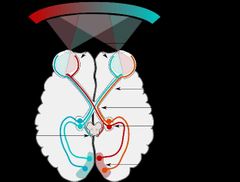
Woohoo |
|
|
What side of the eyes cross and what side doesn't cross at chiasm |
Nasal cross, Temporal stays same side |
|
|
3 components of object seen |
Form, color,motion |
|
|
Parvocellular pathway |
Color and fine detail. (*Parvathy) Not very good at detecting motion and in low level of light
The parvocellular pathway is one of the two main pathways that transmit visual information from the retina to the brain's visual cortex. It primarily processes information about color, fine detail, and slow-moving objects. Cant detect motion |
|
|
Magnocellular pathw |
High temporal resolution: It is specialized for processing information related to motion, depth, and detecting fast-moving objects. This pathway is particularly sensitive to low levels of light and contributes to the perception of overall brightness and contrast in the visual scene. |
|
|
Parallel processing-Visual |
Parallel processing in visual perception: Brain's simultaneous analysis of various visual aspects like color, shape, motion, and depth, enabling quick and efficient understanding of the visual environment. |
|
|
Auditory pathway starting from pinna |
Pinna | v Ear Canal | v | Eardrum | | v | Middle Ear Bones (Ossicles-Incus,stapes,malleus) Pinna | v Ear Canal | v | Eardrum | | v | Middle Ear Bones (Ossicles-Incus,stapes,malleus) -> Oval Window(elliptical window) ----> Cochlea --> Auditory nerve--->>Brainstem Pinna | v Ear Canal | v | Eardrum | | v | Middle Ear Bones (Ossicles-Incus,stapes,malleus) -> Oval Window(elliptical window) ----> Cochlea --> Auditory nerve--->>Brainstem Pinna | v Ear Canal | v | Eardrum | | v | Middle Ear Bones (Ossicles-Incus,stapes,malleus) -> Oval Window(elliptical window) ----> Cochlea --> Auditory nerve--->>Brainstem -> Oval Window(elliptical window) ----> Cochlea --> Auditory nerve--->> Auditory nerve--->>Brainstem |
|
|
Another word for Ear canal |
external auditory meatus |
|
|
Eardrum aka? |
Tympanic membrane |
|
|
Malleus,incus,Stapes a.k.a? |
Hammer,Anvil,Stirrup, response |
|
|
3 smallest bone ,Ossicles: Malleus,incus,Stapes a.k.a? [MIS] |
Hammer,Anvil,Stirrup, response |
|
|
What's the function of round window in ear/cochlea |
the round window acts as a relief valve, enabling the cochlea to function properly by maintaining fluid pressure equilibrium. |
|
|
What's the function of round window in ear/cochlea |
the round window acts as a relief valve, enabling the cochlea to function properly by maintaining fluid pressure equilibrium. |
|
|
Now, what is the organ of corti doing when it 💥. |
The Organ of Corti, situated in the cochlea of the inner ear, houses sensory hair cells that detect sound vibrations. When sound waves cause the basilar membrane to flex, the hair cells bend against the tectorial membrane, generating electrical signals that are transmitted to the brain via the auditory nerve for interpretation as sound. |
|
|
How is pitch distinguished, in place theory of hearing |
pitch of a musical tone is determined by the places where the membrane vibrates,based on frequencies corresponding to the tonotopic organization of the primary auditory neurons. |
|
|
General classification of ear |
o External/Outer ear: from pinna to tympanic membrane o Middle ear: From malleus to stapes (three ossicles) o Inner ear: Cochlea and semicircular canals |
|
|
A detailed conduction/transduction of sound the moment it knocks the Oval window |
When the oval window vibrates, it sets the fluid inside the cochlea into motion, causing the basilar membrane to vibrate. This motion bends the hair bundle on the hair cells, comprising stereocilia and a kinocilium. As the stereocilia bend, mechanosensitive ion channels, primarily gated potassium (K+) channels, open at their tips. This allows potassium ions to enter the hair cell, depolarizing it and generating an action potential.Additionally, calcium ions (Ca2+) play a crucial role in the process. As the stereocilia bend, calcium ions also enter the cell through mechanosensitive channels. This influx of calcium ions triggers the release of neurotransmitters from the base of the hair cell. These neurotransmitters then stimulate nearby auditory nerve fibers, initiating the transmission of electrical signals, now in the form of action potentials, to the brainstem via the auditory nerve.In summary, the bending of the hair bundle due to the motion of the basilar membrane allows for the influx of potassium and calcium ions, which together contribute to the generation of action potentials in the hair cells, ultimately leading to the transmission of auditory signals to the brain. |
|
|
What does spiral Ganglion cell do in ear |
spiral ganglion cells serve as the primary interface between the sensory input from the cochlea and the central nervous system, enabling the perception of sound. |
|
|
Our freq range |
20Hz- 20000hz(20kHz) |
|
|
Low frequency or Long wavelength hits ____ of cochlea , whereas high freq or short wavelength hits____ |
Far end(apex) Immediate end/starting end(base). |
|
|
In what situations, cochlear implants used. |
sensorineural narrow hearing loss – aka `nerve deafness` |
|
|
Working principles of cochlear implant |
Sound -> microphone -> transmitter (outside the skull) sends info to the receiver (inside skull). Then it sends info to the stimulator, into the cochlea, and cochlea converts electrical impulse into neural impulse that goes to brain. Restores some degree of hearing. |
|
|
Proprioception tools |
Muscle SpindlesGolgi Tendon Organs (GTOs)Joint ReceptorsCentral Nervous System (CNS) |
|
|
Proprioception tools |
Muscle SpindlesGolgi Tendon Organs (GTOs)Joint ReceptorsCentral Nervous System (CNS) |
|
|
What's the point of proprioception and what's kinesthesia |
Proprioceptive feedback allows individuals to have an innate sense of where their body parts are relative to each other and to the environment, even without visual input.. Kinesthesia, also known as kinesthetic sense or proprioception in motion, refers to the perception of body movement. Proprioception is cognitive, kinesthesia is behavioral |
|
|
What's the ability to sense temperature and pain. According to khan ,there is a receptor that is used for both |
Thermoception, and nociception . Trpv1 |
|
|
3 types of nerve fibres – in terms of speed |
fast, medium, slow. [Acronym: fast to slowest alphabetically AB, A-D, C].o A-beta fibres - Fast ones are thick and covered in myelin (less resistance, high conductance) o •A-delta fibres -– smaller diameter, less myelin. fast, medium, slow. [Acronym: fast to slowest alphabetically AB, A-D, C].o A-beta fibres - Fast ones are thick and covered in myelin (less resistance, high conductance) o •A-delta fibres -– smaller diameter, less myelin. • C fibres - small diameter, unmyelinated (lingering sense of pain). • C fibres - small diameter, unmyelinated (lingering sense of pain). |
|
|
The gate control theory |
The gate control theory of pain asserts that non-painful input closes the "gates" to painful input, which prevents pain sensation from traveling to the central nervous system. Therefore, stimulation by non-noxious input is able to suppress pain. “Fast blocks slow” Ronald Melzack and Patrick Wall. |
|
|
Pheromones; how do animal sense it |
The accessory olfactory epithelium is a specialized area of tissue located in the nasal cavity, separate from the main olfactory epithelium. It contains sensory receptors known as vomeronasal receptors, which detect pheromones—chemical signals released by animals to communicate with others of the same species. |
|
|
Vmno - activation |
Chemical Signals | V Basal Membrane | V Vomeronasal Receptors Activation | V Apex of VNO | V Vomeronasal Nerve | V Accessory Olfactory Bulb | V Glomerulus (in AOB) | V Mitral Cells | V Integration and Processing in Brain Regions (Amygdala, Hypothalamus, etc.) | V Behavioral Responses |
|
|
The cribriform plate is a |
thin, sieve-like structure in the ethmoid bone of the skull. It forms the roof of the nasal cavity and contains numerous small openings for olfactory nerves, allowing the passage of nerve fibers from the nasal cavity to the brain(olfactory bulb,located just above this plate), contributing to the sense of smell. |
|
|
Area where olfactory nerves lies, |
Olfactory epithelium: in upper nasal cavity |
|
|
What's glomerulus |
In olfaction, the glomerulus refers to a structure within the olfactory bulb, which is part of the brain's olfactory system. It's where axons from olfactory receptor neurons converge and synapse with dendrites of mitral and tufted cells, facilitating the processing of olfactory information. |
|
|
Out of these 5 sensation, smell,hearing,taste,vision and touch. Which one are ipsilateral and contralateral. Which ones goes through Thalamus? |
Smell (olfaction) and taste (gustation) doesn’t synapse on to thalamus and hence are both ipsilateral while vision/hearing/touch are contralateral. |
|
|
End stage of piaget and age |
11+, formal operational |
|
|
N2, and N3 sleep stage waves? |
Theta(+spindle and K). And delta respectively |
|
|
Correlation coefficient and proportion of variant |
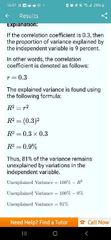
|
|
|
Correlation coefficient and proportion of variant |
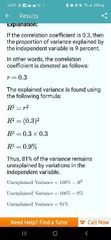
|
|
|
Whats Transducin, 3 diff parts of Transducin |
Its G- P. Which get activated by Rhodopsin. Alpha,Beta and Gamma. |
|
|
Instinctive drift |
Innate behaviors overshadowing a learned behavior. Innate behaviors overshadowing a learned behavior."Trained squirrel to walk, but still on tree"Instinctive drift refers to the tendency of animals to revert to their natural behaviors despite being trained to perform specific tasks. It often occurs when the learned behaviors conflict with the animals' natural instincts. This phenomenon has been observed in various species, including dolphins, dogs, and raccoons, and it highlights the limitations of conditioning and the persistence of innate behaviors |

